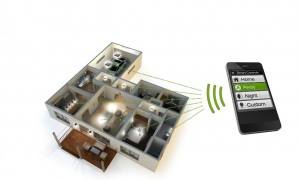
By Katie Fehrenbacher
Updated: Along with our latest gadgets, cell phones, electrical meters and cars, light bulbs and lighting systems, are increasingly getting embedded with chips, connected to wireless networks and moving into the Internet age. The annual massive lighting convention Lightfair International kicks off on Tuesday and chip makers, lighting manufacturers and startups with smart software, are all showing off new networked light bulbs and systems that can manage these lights on an individual bulb basis.
This week chip maker NXP launched a wireless-connected lighting product that can connect both LEDs and CFLs to your home (or commercial building) network. Jessen Wehrwein, NXP’s Director, Marketing Programs for Power & Lighting, explained to me in an interview that the so-called GreenChip package — which includes the microprocessor, power supply and the driver — adds about $1 to the cost of the bulb, and embeds the chip directly in the base of the bulb. The company is showing off its connected lighting system along with light maker TCP and energy management startup Greenwave Reality at Lightfair this week.
NXP’s connected lighting systems run over the low power wireless standard 6LoWPAN, which is an emerging standard that is being used for wireless sensor and control networks. On Tuesday NXP is also announcing that it is open sourcing the software that it uses to wirelessly manage the lighting systems over 6LoWPAN, called JenNet. Wehrwein tells me that there are few established standards in the home wireless industry, which is why the company wants to open source its own IP-based and standardized solution. Similarly, Google and Lighting Science Group announced last week that they are working on an open source wireless lighting standard to connect lighting and other devices in the home via the Android platform.
NXP, Lighting Science Group and Google don’t seem to be interested in using the more common WiFi or basic ZigBee for these wireless networks, because of a variety of things like power constraints, latency issues, and the complexity of chips. Wehrwein also noted to me that WiFi is only as robust as each individual node (think if one light in a set of Christmas lights goes out, the whole thing crashes), whereas 6LoWPAN is based on wireless mesh, so it can basically be self-healing.
NXP’s GreenChip package can be used with both CFLs and LEDs, and Wehrwein said that the company wanted to include CFLs because LEDs won’t likely be mainstream for at least 2 to 3 years down the road, or until the high price of LEDs comes down substantially. While incandescent lights are in the couple-dollar range, CFLs are in the $4 to $10 range, and LEDs are in the $40 to $50 range.
Chips and networks are also being used to improve the quality of LEDs, which are still often times substandard to the incandescents that consumers have grown used to. At Lightfair this week chip maker Marvell also launched a chip that can improve the lighting quality of LEDs by controlling the current and temperature of two types of combined LED light sources, and also by enabling the addition of a wireless chip (Updated).
Beyond chips for every bulb, digital lighting management systems are an early but growing product for industrial and commercial customers. Redwood Systems is a three-year-old company that makes a control and sensor system for LEDs that runs over an optimized version of ethernet cables, and other companies in this space include Digital Lumens, Adura Technologies, and building automation companies Honeywell and Johnson Controls.
Article Courtesy of: http://gigaom.com

